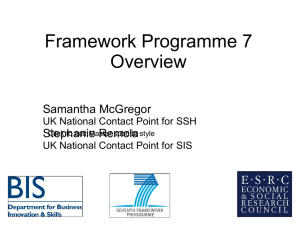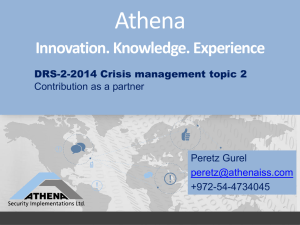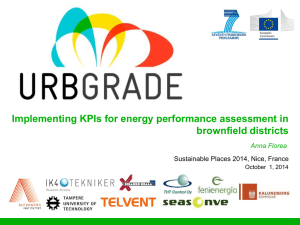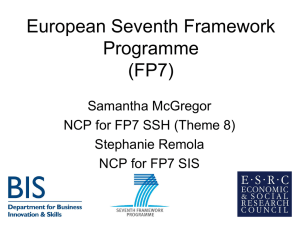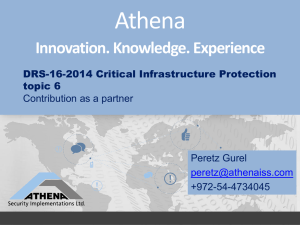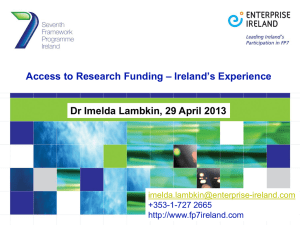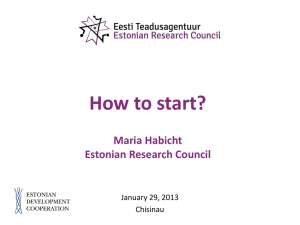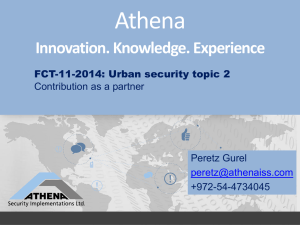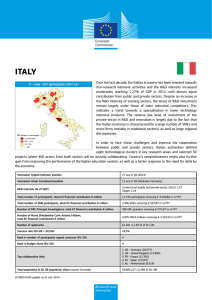FP7 - Home pages of ESAT
advertisement
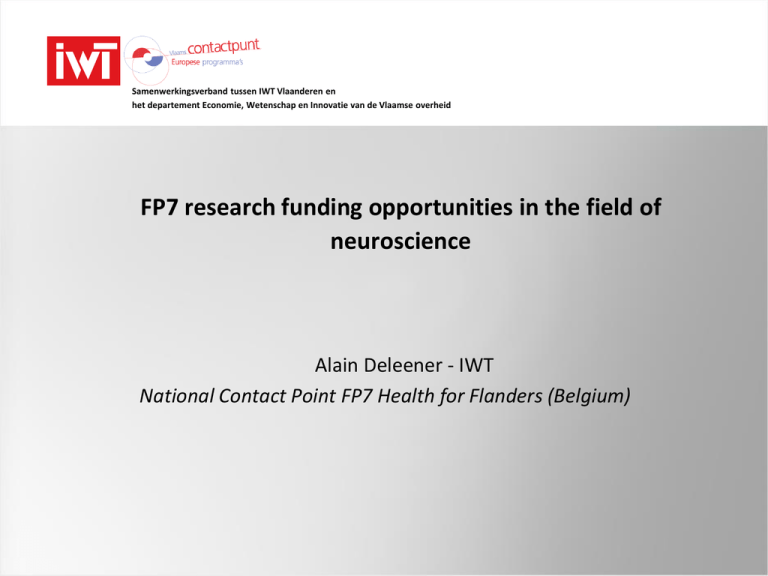
Samenwerkingsverband tussen IWT Vlaanderen en het departement Economie, Wetenschap en Innovatie van de Vlaamse overheid FP7 research funding opportunities in the field of neuroscience Alain Deleener - IWT National Contact Point FP7 Health for Flanders (Belgium) EU support for Research and Innovation FP7 funding opportunities for neuroscience complementary programmes, from research to market. • The €55 billion Seventh Framework Programme supports basic and applied research activities, still far from the market, leverages money and concentrate resources on strategic research areas, always on the basis of technological and scientific excellence. • The Competitiveness and Innovation Framework Programme does not finance research, but supports innovation activities, provides better access to finance and delivers business support services in the regions. • Structural funds have just as much funding as FP7, however FP7 concentrates on excellence for competitiveness, while the Structural Funds' main objective is cohesion. However, there are synergies between these programmes. 2 FP7 Structure and Budget FP7 funding opportunities for neuroscience EC Framework Programme is delineated into four Specific Programmes; total budget of € 50.52 billion Euratom Cooperation JRC (EC) 4,061 1,751 Capacities 4,097 Ideas (European Research Council) People 4,75 Cooperation 32,413* People 7,51 Ideas Capacities *of which Health € 6.1 billion Total FP7 budget, including EURATOM: € 54,582 billion Collaborative research in FP7: The Cooperation programme FP7 funding opportunities for neuroscience Thematic Priorities 1. 2. 3. 4. 5. 6. 7. 8. 9. Health Food, agriculture, fisheries and biotechnology Information and communication technologies Nanosciences, nanotechnologies, materials and new production technologies Energy Environment (including climate change) Transport (including aeronautics) Socio-economic sciences and the humanities Security & 10. Space Total for collaborative research 6.1 1.9 9.1 3.5 2.3 1.9 4.2 0.6 2.8 €32.4 billion 4 Cooperation – ‘Tools’ FP7 funding opportunities for neuroscience • Under each theme there will be sufficient flexibility to address both Emerging needs and Unforeseen policy needs • Dissemination of knowledge and transfer of results will be supported in all thematic areas • Support will be implemented across all themes through: Collaborative research (Collaborative projects; Networks of Excellence; Coordination/support actions) Joint Technology Initiatives Coordination of non-Community research programmes (ERA-NET; ERA-NET+; Article 169) International Cooperation Collaborative research in FP7: The Cooperation programme FP7 funding opportunities for neuroscience Thematic Priorities 1. 2. 3. 4. 5. 6. 7. 8. 9. Health Food, agriculture, fisheries and biotechnology Information and communication technologies Nanosciences, nanotechnologies, materials and new production technologies Energy Environment (including climate change) Transport (including aeronautics) Socio-economic sciences and the humanities Security & 10. Space 6.1 1.9 9.1 3.5 2.3 1.9 4.2 0.6 2.8 Total collaborative research for €32.4 billion 6 Scope of research in the Health Theme FP7 funding opportunities for neuroscience • In the Health theme, the Framework programme can support both basic and applied research • This includes discovery activities, translational research and clinical trials (normally only phase I and II). Health research in FP7 FP7 funding opportunities for neuroscience Pillar 1: Pillar 2: Pillar 3: Biotechnology, generic tools & technologies for health Translating research for human health Optimising the delivery of health care cross-cutting issues: child health, the health of ageing population gender-related health issues Budget: € 6.1 billion over 7 years (2007-2013) Public Health Translational Biotech Health Health research in FP7 1: Biotechnology, generic tools and technologies FP7 funding opportunities for neuroscience High-throughput research technologies for: sequencing (genotyping, phenotyping, gene expression) structural / functional genomics, bioinformatics, systems biology Detection, diagnosis and monitoring tools and technologies for: visualisation, imaging, detection and analysis Predicting suitability, safety and efficacy of therapies pharmacogenomics, biomarkers, targeting and delivery approaches (incl. alternatives to animal testing), and in vivo methods and models Innovative therapeutic approaches & intervention Public Health Translational Biotech Health gene and cell therapy, regenerative medicine, transplantation, immunotherapy and vaccines Health research in FP7 2: Translating research for human health (1) FP7 funding opportunities for neuroscience Integrating biological data and processes large-scale data gathering: generate data to elucidate the function of genes and gene products and their interaction in complex networks systems biology: to develop and apply systems approaches to understand and model biological processes Research on the brain and related diseases to better understand the integrated structure and dynamics of the brain, and to study brain diseases, incl age-related ones: dementia, Parkinson Human development and ageing Public Health Translational Biotech Health to better understand the process of life-long development and healthy ageing Health research in FP7 2: Translating research for human health (2) FP7 funding opportunities for neuroscience Translational research in infectious diseases: drug resistance HIV / AIDS, malaria, tuberculosis hepatitis new and re-emerging epidemics Translational research in major diseases: (~ 20-25% of request) Public Health Translational Biotech Health cancer cardiovascular disease diabetes / obesity rare diseases other chronic diseases e.g. rheumatic, respiratory, musculo-skeletal diseases & arthritis) Health research in FP7 3: Optimising the delivery of health care FP7 funding opportunities for neuroscience Translating clinical outcome into clinical practice patient safety, best clinical practice, decision making in clinical settings in primary and specialised care, foster application of evidence-based medicine Quality, efficiency and solidarity of health systems organizational, financial and regulatory aspects of health systems Public Health Translational Biotech Health Enhanced disease prevention and better use of medicines provide scientific evidence for best public health measures Work programme 2010 preparation (4th call) Roadmap FP7 funding opportunities for neuroscience Strategy Paper >> DG and Commissioner (Nov.-Dec.‘08) Reflection paper >> 1st PC meeting (12 January ‘09) Draft WP >> 2nd PC meeting (5 March ‘09 ?) Draft WP >> Inter-service Consultation (May) Draft WP >> PC formal opinion (June) Work Programme adoption (July) & publication in July or September Research priorities for 4th call FP7 funding opportunities for neuroscience Important features: • focus on 4 key research challenges • some areas closed • will probably be split into 2 or 3 calls • 2-stage submission for some areas/topics focus on 4 Key Research Challenges • Providing tools for translational research • Structuring translational research in the field of cancer • Structuring translational research in the field of neurodegenerative diseases. • Better health for Africa Funding schemes in the Health theme (4th call) FP7 funding opportunities for neuroscience Funding schemes upper limits Large-scale integrating project (CP-IP) €12m Network of excellence (NoE) to be specified Small- or medium-scale focussed research project (CP-FP) €3m or €6m Coordination action (CA) €2m Support action (SA) €0.5m FP7 – Health 4th call topics (1/5) FP7 funding opportunities for neuroscience Biotech, tools & technologies 1.1 – High-throughput research 1. Harmonisation of phenotyping and biosampling for clinical research. Funding scheme: Large scale integrating project. ! Topics communicated with reservation ! FP7 – Health 4th call topics (2/5) FP7 funding opportunities for neuroscience Biotech, tools & technologies 1.2 – Detection, diagnosis and monitoring 1. Tools for the identification and the detection of biomarkers in clinical samples and patients. • Multimodality biomarker analysis • Tools for detection, isolation and functional characterization of complexes of interacting molecules for diagnostic purposes • Development of new quantitative imaging biomarker(s) for monitoring therapeutic effects and safety in chronic diseases • High throughput molecular diagnostic imaging • Development and implementation of quantum imaging of X-rays/Y-rays for diagnosis Funding scheme: Small or medium-scale focused research projects. (2-stage) ! Topics communicated with reservation ! FP7 – Health 4th call topics (3/5) FP7 funding opportunities for neuroscience Translating research for health 2.1 – Integrating biological data and processes: 2.1.2 – Systems biology 1. Tackling Human Diseases through Systems Biology Approaches. Funding scheme: Large-scale integrating projects. (2-stage) 2. Creating European multidisciplinary networks to address systems biology of basic biological processes relevant to health. Funding scheme: Network of Excellence. (2-stage) 3. Coordination and support actions in large-scale data gathering and systems biology. Funding scheme: Coordinating Action. 4. Developing new and improving existing mathematical algorithms for systems biology. Funding scheme: SICA Small or medium-scaled focused research project ! Topics communicated with reservation ! FP7 – Health 4th call topics (4/5) FP7 funding opportunities for neuroscience Translating research for health 2.2.1 – Research on the Brain and related diseases: 1. Validation of strategies for treating addiction. Funding scheme: Large scale integrating project. 2. Actions to support dissemination of scientific knowledge in neuroscience. Funding scheme: Supporting Action. Also considering possible initiatives linked to Joint Programming for research on neurodegenerative diseases. ! Topics communicated with reservation ! FP7 – Health 4th call topics (5/5) FP7 funding opportunities for neuroscience Translating research for health 2.2.2 – Human development and ageing: 1. Role of early-life developmental processes in longevity determination. Funding scheme: Large-scale integrating project. (2-stage) 2. Homeostasis in human development and its effects on lifespan. Funding scheme: Small or medium-scale focused research project. (2-stage) ! Topics communicated with reservation ! Collaborative research in FP7: The Cooperation programme FP7 funding opportunities for neuroscience Thematic Priorities 1. 2. 3. 4. 5. 6. 7. 8. 9. Health Food, agriculture, fisheries and biotechnology Information and communication technologies Nanosciences, nanotechnologies, materials and new production technologies Energy Environment (including climate change) Transport (including aeronautics) Socio-economic sciences and the humanities Security & 10. Space Total for collaborative research 6.1 1.9 9.1 3.5 2.3 1.9 4.2 0.6 2.8 €32.4 billion 21 FP7 – ICT call topics (1/4) FP7 funding opportunities for neuroscience Challenge 2: Cognitive Systems and Robotics Objective ICT-2009.2.1: Cognitive Systems and Robotics “Pertinent research may be informed by neuro- and behavioural sciences and determine the requirements basic technologies have to meet in order to enable creating the targeted systems.” FP7 – ICT call topics (2/4) FP7 funding opportunities for neuroscience Challenge 4: Towards sustainable and personalised healthcare Objective ICT-2009.5.1: Personal Health Systems Target outcome b): Mental health ICT based solutions for persons suffering from stress, depression or bipolar disorders (other mental disorders are not in scope).Interdisciplinary research will address the parallel development of technological solutions, as well as new management or treatment models based on closed-loop approaches. Emphasis will be on the use of multiparametric monitoring systems, which monitor various metrics related to behaviour and to bodily and brain functions (e.g. activity, sleep, physiological and biochemical parameters). Objective ICT-2009.5.3: Virtual Physiological Human “Coordination/Support action to develop an observatory on the achievements and evolution of the broader Biomedical Informatics field which builds on synergies between bioinformatics, medical informatics, and neuroinformatics. The action should incorporate intensive dissemination and training components and facilitate communication between projects. FP7 – ICT call topics (3/4) FP7 funding opportunities for neuroscience Challenge 7: ICT for Independent Living, Inclusion and Governance Objective ICT-2009.7.2: Accessible and Assistive ICT “ICT restoring and augmenting human capabilities compensating for people with reduced motor functions or disabilities: Radically new ICT-enabled approaches to restore and augment the ability of people in their daily life with a focus on reduced motor functions. Research should aim for breakthroughs in the way humans interact with computers and how they may overcome their disability and augment their capabilities. The research should build on progress in non-invasive sensor and actuator concepts for brain/neuronal-computer interaction (BNCI), smart bio-sensors, selflearning/adaptive systems and advanced signal processing.” FP7 – ICT call topics (4/4) FP7 funding opportunities for neuroscience 4.8 Future and Emerging Technologies (Open call – cut off dates) Radical breakthroughs in ICT increasingly rely on fresh synergies, crosspollination and convergence with different scientific disciplines (for instance, biology, chemistry, nanoscience, neuro- and cognitive science, ethology, social science, economics) and with the arts and humanities. Objective ICT-2009.8.4: FET proactive 4: Human-Computer Confluence. Objective ICT-2009.8.8: FET proactive 8: Brain Inspired ICT Target outcome a) Development of multi-scale models of information processing and communication in the brain and/or PNS. b) Synthetic Hardware Implementations of Neural Circuits FP7 – ICT future calls FP7 funding opportunities for neuroscience Next calls in 2009 • in June (deadline October/November) • in November (deadline beginning 2010) • every 2 calls all topics will be open FET : open call with cut off dates FP7: from call to project FP7 funding opportunities for neuroscience Calls proposals e-proposal EPSS evaluation ranking EC decision negotiation GPF-file GA Project 27 Evaluation & submission procedures FP7 funding opportunities for neuroscience • Evaluations may follow a single or a two-step evaluation procedure or two-stage submission procedure • The applicable procedure will be set out in the call • Two-step evaluation procedure, only proposals that pass the 1st step, based on the evaluation against a limited set of criteria, will go forward for further evaluation • Two-stage submission procedure, only applicants whose proposals pass the evaluation for the 1st stage will be requested to submit a complete proposal in the 2nd stage 28 Brussels 30 Jan 2007 Who can participate? FP7 funding opportunities for neuroscience • Any undertaking, university or research centre or other legal entity, whether established in a: o Member State (MS) o Associated country (Ac) , or o third country • Joint Research Centre (JRC) - is deemed to be established in another MS or Ac • International organisations and participants from third countries can participate only if in addition to the minima 29 Brussels 30 Jan 2007 Conditions for participation FP7 funding opportunities for neuroscience • Minimum condition, general rule, at least 3 independent participants from 3 different MS or Ac • Additional conditions can be established by the SP or WP (number or type of participant, place of establishment) • Specific conditions may also apply for: o Frontier research actions, at least 1 legal entity established in a MS or Ac o Collaborative projects addressing the participation of International Cooperation Partner Countries (ICPC) minimum is 4 participants, 2 of which from MS or Ac and another 2 from ICPC countries unless otherwise foreseen in the WP 30 Brussels 30 Jan 2007 Criteria for evaluation FP7 funding opportunities for neuroscience • The Commission will evaluate the proposals submitted according to the following main criteria: o Scientific and/or technological excellence o relevance to the topic of the call o quality and efficiency of the implementation and management o potential impact of project results • Additional requirements on the application of these criteria may be added in the work programmes • For research actions under the IDEAS Programme the sole criterion of excellence will apply 31 Brussels 30 Jan 2007 Eligibility for funding FP7 funding opportunities for neuroscience • Legal entities from MS and Ac or created under Community law and the JRC • International European interest organisations • Legal entities established in international cooperation partner countries (ICPC), and • International organisations and legal entities from third countries other than ICPC only if: o provided for in SP or WP; or o their contribution is essential for carrying out action; or o provision for funding is provided for in a bilateral agreement between Community and the third country 32 Brussels 30 Jan 2007 Upper funding limits FP7 funding opportunities for neuroscience Reimbursement will be according to the type of action and/or activity • Research and technological development activities: up to 50% of eligible costs, or up to 75% for: • Non profit public bodies • secondary and higher education establishments • research organisations • SMEs • Security related research, for highly reliable capabilities with impact on security of European citizens and targeted to a limited number of public users • Demonstration activities: up to 50% • Other activities including management: up to 100% • Actions that will be reimbursed up to 100%: • Frontier research • Coordination and support • Training and career development of researchers 33 Brussels 30 Jan 2007 Reimbursement of eligible costs FP7 funding opportunities for neuroscience • Most funding schemes use reimbursement of eligible costs o Eligible actual (average personnel costs may be used if do not differ significantly from actual) incurred during duration of project in accordance with the beneficiary usual accounting and management principles recorded in the accounts of beneficiary used for the sole purpose of achieving the objectives of the project o Non-eligible (identifiable indirect taxes including VAT…) 34 Brussels 30 Jan 2007 Indirect Cost FP7 funding opportunities for neuroscience • Participants may charge eligible direct and indirect costs • Reimbursement of indirect costs : o For all: either actual overhead, or simplified method, or flat rate of 20% of direct costs o For Non profit Public Bodies, Secondary and Higher Education establishments, Research Organisations, and SMEs unable to identify real indirect costs, may apply for a flat rate of 60% for funding schemes with Research, Technological Development & Demonstration o For Coordination and Support Actions limit of 7% of direct costs 35 Brussels 30 Jan 2007 How to use FP7 Do and don’t… FP7 funding opportunities for neuroscience • Match your objectives with the Programme funding opportunities. Have a clear vision of what you want to get. • Do it only if it corresponds to your strategic goals. • Use the various supporting options…. 36 Consortium size and composition FP7 funding opportunities for neuroscience There is no ideal size: whether it is for small, medium or large proposals, the consortium must be composed of the right set of competences and resources large Integrating projects do not necessarily require large consortia there are not “political” / “geographical” requirements, although there should not be obvious imbalances eg: 5 out of 7 partners from same country Key factors for success in applying for FP7 funding FP7 funding opportunities for neuroscience Competition is tough: only the best projects get funded The proposal must be in scope with the topic and the work programme (not wishful thinking) The consortium of partners must be excellent and appropriate for the task (select the right partners) The proposal must address all 3 criteria Convince the evaluators (don’t rely on reputation) and, of course, respect the basic rules (deadlines, n° participants, ceilings, length, ethics, …)
